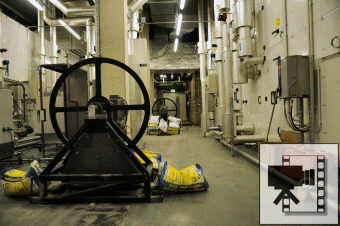On the November 18, 2009, students and researchers of the Civil Engineering Structural Dynamics Group (CESDyn) of the Department of Civil Engineering (DTU Byg) managed to noticeably excite one of the two twin 103m tall towers of the European Court of Justice in Luxembourg. Testing was being undertaken to determine the dynamic properties of the tower, before and after the application of a tuned liquid damper system designed by Assoc. Professor Christos Georgakis. The East Tower was excited to a level of approximately 3 mille-g acceleration or 6 mm displacement from peak to peak. The level represents only a fraction of that that might be expected by the towers during their lifetime, but was nevertheless felt by all the occupants of the top floors, with most describing the motion as being unpleasant after some time.

View on the the twin towers of the European Court of Justice , Luxembourg.
The excitation was achieved using DTU Byg’s full-scale structural centrifugal exciters that have been designed and built in house. The exciters are capable of testing large structures, such as building and bridges, with vibration frequencies of up to 2.2 Hz. The three exciters move up to a total of 1.5 tons ofmass dynamically to excite structures to levels that are at or above comfort levels (for buildings) or at the maximum expected dynamic response (for other structures).

Exciters mounted on the upper technical service floor of the tower
building. The video shows the exciters in action and how the building
moves relative to the lamps hanging from the ceiling (wmv format).
After the application of the tuned liquid damper system, there was a significant drop of the acceleration levels, from about 3 mille-g to 0.5 mille-g. The six-fold decrease in response is a direct result of the 6-fold increase in structural damping that can be attributed to the damping system, proving the effectiveness of the damper design.
The full test campaign was undertaken from November 16 – 20. The testing forms the core of the MSc project, entitled “Determination of the Dynamic Characteristics of Large Structures through Full-Scale Testing”, which is being undertaken by MSc students Joan Hee Roldsgaard and Mads Christiansen. Christos Georgakis is main supervisor for the project, whilst Assoc. Professor Holger Koss is acting co-supervisor. Others involved in the planning and execution include PhD student Einar Ingólfsson and laboratory technician Jonathan Schwartz. InCA Consulting Engineers, based in Luxembourg, are the tower designers and have been close partners with DTU Byg on this project from the beginning.

Team testing the tower building with forced excitation (November 19, 2009). From leftto right - Joan Hee Roldsgaard, Mads Christiansen, Einar Ingólfsson, Anders Brandt, Rune Brincker and Christos Georgakis.
As part of collaborative research project that is being undertaken between the DTU Byg and the University of Southern Denmark, a series of Operational Modal Analysis (OMA) tests were conducted in parallel by Professor Rune Brincker and Assoc. Professor Anders Brandt. The frequencies and damping of the tower were accurately predicted from the OMA and used to calibrate the tests undertaken by DTU Byg.
It must be noted that the tests are considered unique, as there is no other known forced excitation tests, where the dynamic properties of a structure of this scale have been determined before and after the application of additional damping. Furthermore, this has never been performed together with ambient vibration testing. Ambient vibration monitoring of the East Tower continues.
For more information regarding this project, feel free to contact Christos Georgakis at cg@byg.dtu.dk.